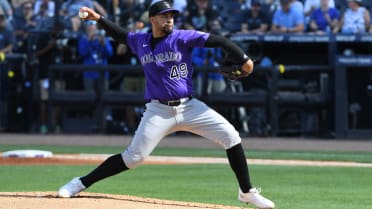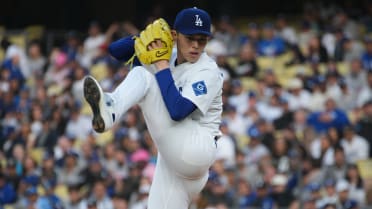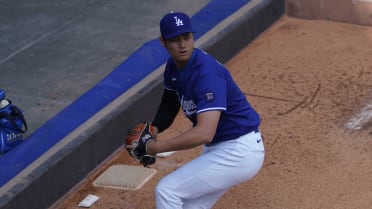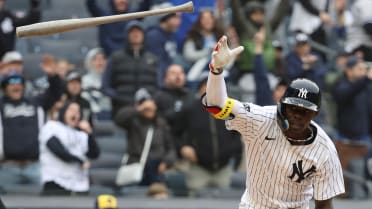For Japan's all-time high school home run leader -- a lefty-slugging phenom who went to the same school as Shohei Ohtani … and outhomered him -- the road to the Major Leagues goes through Trenton, N.J.
That's where 19-year-old Rintaro Sasaki has been slugging home runs while he waits for his college baseball career at Stanford to begin.
Sasaki, who hit 140 homers for Hanamaki Higashi High School, Ohtani's alma mater, was expected to be the No. 1 overall pick in the Nippon Professional Baseball Draft. Instead, he decided to play college ball in the U.S. for the Cardinal, after which he will, presumably, enter the MLB Draft, as early as 2026. It's a road not taken by top Japanese prospects. Those who have starred in MLB, from Shohei Ohtani to Yu Darvish to Masahiro Tanaka to Hideki Matsui to Ichiro Suzuki, have all come by way of NPB. But Sasaki will try to blaze that trail.
More from MLB Pipeline:
• Top 100 prospects | Stats | Video | Podcast | Complete coverage
"When I was evaluating the doors that were open for me -- and fortunately, I had a lot of doors -- I considered which ones would be able to maximize my potential," Sasaki said via his interpreter, Chihiro Tsukamoto, this week, sitting down for an interview with MLB.com. "That, combined with, I really have this intense passion and desire to play college baseball in the USA."
He added: "And it has always been my childhood dream to play in MLB."
So for now, here he is, hammering away in the MLB Draft League, Major League Baseball's developmental summer league for amateur players to help them prepare for a career in pro ball, before he heads off to play at Stanford next season.
Sasaki made his debut for the Thunder on June 11, and now the 6-foot, 230-pound corner infielder has four homers in 23 games, second-most in the Draft League. In his mind, those 140 home runs, the spotlight that shined on him in Japan and the legacy at Hanamaki Higashi to rival Ohtani's, are an ocean away.
"It's true that I went to the same high school as the great Shohei Ohtani," Sasaki said. "But regarding my own high school career, and my own record, I don't really think about it very much. I'm not very interested in resting on my own laurels. I just want to get better as a player.
"I just think forward and upwards."
This is where Sasaki's path diverges from Ohtani's. In 2012, when Ohtani was coming out of Hanamaki Higashi, he nearly did what Sasaki is seeking to do now, announcing his intention to pursue an MLB career over NPB. But the Hokkaido Nippon-Ham Fighters drafted Ohtani nonetheless, and persuaded him to play with the promise of allowing him to be a two-way player.
Sasaki, who came up in Ohtani's shadow, can't avoid the connection to the two-way superstar. Nor would he want to. The two players are linked by more than just their greatness on the field in Japan.
Sasaki's father, Hiroshi, is the coach of the Hanamaki Higashi baseball team. He coached both Ohtani and Blue Jays left-hander Yusei Kikuchi there, and finally, his own son.
"Putting aside the fact that he's my dad, as a coach, he's a really phenomenal coach, and he cares a lot about his players," Sasaki said. "Because of his teaching, I'm able to be here as the player I am today."
So Rintaro has known Ohtani and Kikuchi for most of his life. His two storied Hanamaki Higashi predecessors have both lent their wisdom to Sasaki along his baseball journey.
"I am extremely proud to have gone to the same high school as them and very grateful for their support," Sasaki said. "We were able to talk about my decision to come to Stanford, and they gave me some practical advice about moving to the USA. And about the pros -- about being a baseball player in the USA. And the cultural differences between Japanese baseball and American baseball."
Sasaki said his transition from Japan to the U.S. has been smoothed by Ohtani and Kikuchi's advice. So has his practicing of English, which he's been doing for months. Sasaki hasn't done much exploring yet ("I wake up, I go to the field, I train, I train some more, I play and then I go back home and sleep," Sasaki said), but he hopes to get the full American college experience at Stanford starting this fall.
He's already spent some time on campus before coming to Trenton, and said both that time and his time in the Draft League have also helped him adjust to life -- and baseball -- in the U.S.
"There are indeed several cultural differences between American and Japanese baseball, but many things are the same," Sasaki said. "Baseball is a universal language."
On the field, his success in the Draft League -- which includes several big homers -- is promising. Sasaki crushed a moonshot home run in his U.S. debut; the Hall of Fame asked for his bat after that one. A few weeks later, he mashed his first grand slam while his team pitched a no-hitter.
Sasaki's average exit velocity of 92.1 mph is tied for the highest in the Draft League (and would be a top tier exit velocity in the Major Leagues). He's reached a max exit velo of 108.1 mph, and he has two of the top five hardest base hits of the season. His home runs have left the bat at speeds of 99.7 mph, 101.3, 106.0 and 103.9.
When you consider Sasaki's slugging feats in Japan, these Draft League results are not surprising. But the 19-year-old is also having to adjust to higher pitch velocities and a wider array of pitch types in the U.S. than he faced in Japan. That's one of the purposes of him joining the Draft League. Sasaki's future MLB Draft stock, and his Major League dream, will depend on his learning of how to handle the caliber of pitching he'd face in the big leagues.
"I'm very proud of my record and hitting all those home runs in Japan," Sasaki said. "However, that was then and this is now. I'm very aware that high school is high school and now the level is completely different. My record in Japan has contributed to my self-confidence as a player, but I don't at all think that I've developed my full potential.
"And so, people compare me to Shohei Ohtani a lot, but personally, I know that I'm not at his level yet. Although that is my dream."
Sasaki hopes to become the type of feared lefty slugger whose prodigious home run power strikes fear into even Major League aces.
He admires the playing style of Phillies stars Bryce Harper and Kyle Schwarber -- who play a stone's throw away from Trenton, just across the Delaware River -- and tries to model some of his own offensive game after theirs. And growing up, Sasaki of course idolized Ohtani, but also David Ortiz, and above all, Barry Bonds, for the show that MLB's home run king could put on in the batter's box.
"I wanted to take on some of his style and the type of player that he is. The fact that I am the kind of player that I am is really impacted by him and his style of play a lot," Sasaki said of Bonds.
"I admired Barry Bonds the first time I ever saw him bat. And from then on, I always looked up to him and wanted to be the kind of player that he was."
But that is a long way away, still. Sasaki knows how much work has to be done for this path he's creating for himself to end with him in the Major Leagues, crushing home runs like Bonds and playing alongside Harper, Schwarber and Ohtani.
"Of course I do have an ideal type of player I want to be. But I haven't reached that goal yet," Sasaki said. "Right now, I would like to develop upon the solid foundation I've built as a player in Japan. I want to continue on and improve further. That's the kind of player who I want to be."
David Adler is a reporter for MLB.com based in New York.




